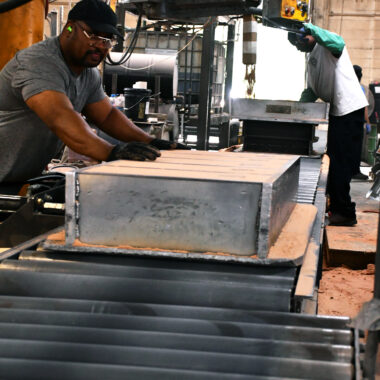Crafting Brilliance: Browsing the World About Aluminum Casting
Crafting Brilliance: Browsing the World About Aluminum Casting
Blog Article
Crafting Excellence: Exactly How to Accomplish High-Quality Light Weight Aluminum Castings Each Time
In the realm of aluminum casting, the pursuit of excellence is a constant trip that calls for a thorough approach and an eager understanding of the intricacies involved. Accomplishing regular high-quality aluminum castings demands a comprehensive grasp of the processes, from picking the suitable alloy to implementing precise mold layouts and meticulously controlling spreading specifications. Nonetheless, real proficiency depends on the capability to implement these aspects effortlessly to create remarkable castings each time. As we check out the ins and outs of crafting perfection in aluminum spreadings, revealing the key strategies and strategies that lead to impeccable outcomes becomes extremely important for those pursuing excellence in this customized field.
Understanding Aluminum Casting Processes
Light weight aluminum casting procedures, essential in the manufacturing sector, involve the complex transformation of liquified aluminum right into strong kinds via a collection of very carefully controlled actions. Comprehending these processes is paramount to accomplishing top quality aluminum spreadings continually - about aluminum casting. The key methods used in aluminum spreading are pass away casting, sand casting, and financial investment casting

Each of these processes has its advantages and is selected based on aspects like intricacy, quantity, and preferred coating of the aluminum casting. about aluminum casting. Comprehending the ins and outs of these methods is important for suppliers aiming to produce top notch light weight aluminum castings regularly
Selecting the Right Light Weight Aluminum Alloy
Picking the appropriate aluminum alloy is an important decision in the production of high-quality light weight aluminum spreadings. The choice of alloy substantially influences the properties and characteristics of the final product. Various light weight aluminum alloys use differing levels of stamina, rust resistance, machinability, and thermal conductivity. When selecting a light weight aluminum alloy for spreading, it is necessary to think about the details needs of the application to make sure optimum efficiency.
Among the most frequently utilized aluminum alloys for spreading is A356. This alloy offers superb castability, high toughness, and excellent deterioration resistance, making it ideal for a vast range of applications. 6061 aluminum alloy is preferred for its premium weldability and good mechanical residential or commercial properties. For applications needing high stamina, 7075 light weight aluminum alloy is a prominent choice due to its exceptional strength-to-weight proportion.
In enhancement to mechanical residential check these guys out or commercial properties, considerations such as cost, schedule, and post-casting processes ought to also influence the option of the appropriate aluminum alloy. By thoroughly examining these variables, suppliers can ensure the production of premium aluminum castings that fulfill the wanted specs.
Implementing Correct Mold Layout
Developing a reliable mold layout is essential for making sure the effective production of top notch light weight aluminum castings. Appropriate mold design plays a significant duty in attaining the preferred features of the final item. To execute an effective mold style, aspects such as material these details circulation, cooling down rates, and part geometry must be thoroughly considered.
One key element of mold and mildew style is making certain proper dental filling and solidification of the aluminum within the mold dental caries. This involves developing runner and gating systems that facilitate smooth steel circulation and avoid problems such as air entrapment or insufficient filling. Furthermore, including air conditioning channels right into the mold style aids control solidification rates and lower the danger of porosity or contraction problems.

Controlling Casting Parameters

Ensuring Post-Casting High Quality Checks
To keep the high quality of aluminum castings, detailed post-casting high quality checks are necessary. After the casting process is finished, it is essential to make sure that the final products meet the desired criteria and specs.
Dimensional accuracy is an additional crucial element that should be validated throughout post-casting top quality checks. Dimensions of essential dimensions and tolerances should be taken to confirm that the spreadings satisfy the needed requirements. Furthermore, mechanical homes such as hardness, tensile strength, and effect resistance may need to be examined via material screening to make certain that the castings have the required strength and durability for their designated application.
Conclusion
To conclude, accomplishing premium light weight aluminum spreadings needs a detailed understanding of the spreading procedures, picking the ideal alloy, developing mold and mildews successfully, controlling casting specifications carefully, and conducting post-casting quality checks vigilantly. By adhering to these steps, manufacturers can regularly produce aluminum spreadings that meet the greatest standards of top quality and efficiency.
Accomplishing constant top quality aluminum castings demands a thorough understanding of the processes, from selecting the proper alloy to carrying out accurate mold styles and thoroughly controlling spreading criteria. The primary methods used in aluminum spreading are die spreading, sand casting, and investment casting.
Investment casting, likewise understood as precision casting, includes creating wax patterns that are covered in ceramic to create molds.Picking the proper aluminum alloy is a critical choice in the manufacturing of high-grade light weight aluminum castings.Making sure exact control over casting specifications is vital for keeping uniformity and quality in aluminum casting production.
Report this page